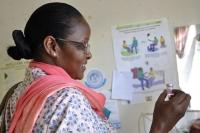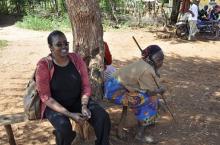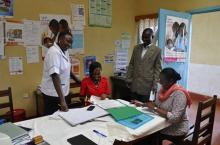Finding Every Last Poliovirus
Surveillance Officers like Amina Ismail in Kenya spend their days chasing the poliovirus to its final hiding places, so that it can be stopped forever.
Eradicating polio from the world forever will be one of the biggest public health achievements of our time. Surveillance Officers like Amina Ismail, working for the World Health Organization, know that it is not just vaccinating every last child but being able to trace every last virus that will take us over the finishing line to eradication.
“Disease surveillance is one of the pillars of polio eradication,” Amina explains. “If people don’t know where the disease is, we will not be able to eradicate it.”
In 2013, an outbreak of polio paralysed 14 children across Kenya, a country which had previously stopped polio transmission. Amina is one of a team of seven surveillance officers who have worked relentlessly since the outbreak, alongside Ministry of Health and other partner organizations of the Global polio Eradication Initiative, to ensure that no case of polio goes unreported. Their work entails travelling from one facility to another, between homes, schools and communities, searching for cases of polio.
It is Amina’s ability to engage and motivate the people at the heart of the system that makes her so good at her job. She spends her day sensitizing and educating doctors, nurses, traditional healers and influential members of communities about the principles of polio surveillance, strengthening data systems and building capacity using the expertise she has gathered through many years of disease surveillance.
The people within surveillance
This week, Amina is in Tharaka Nithi, one of five counties she travels between each month. She begins her day by meeting with Isaiah Kabul, the District Surveillance Coordinator, and Jennifer Mbithe Nduva, a Data Collection Officer. Tharaka Nithi has failed to report a child with acute flaccid paralysis (AFP), the symptom that indicates the possible presence of polio, since 2013. “Most people haven’t seen actual polio; they have only read about it,” explains Amina, emphasising the need to maintain vigilance. In an area the size of Tharaka Nithi, it is an anomaly for there to have been no AFP case in this much time, as it can be caused by several things, not just polio. Amina knows that if no AFP cases are reported and tested, then polio has the chance to silently return unnoticed.
After a long drive along dirt tracks they reach Ciakagira Health Centre where Amina meets with Emily, the nurse in charge. “I am here to support you, not to root for mistakes,” Amina reassures her as they check through the case register and the disease surveillance weekly report. At every clinic, one member of staff is assigned as the surveillance focal point for any suspected case of AFP, who must also make sure all staff know what to look for and that they report it.
Next, Amina asks Emily what symptoms would alert her to the possible presence of polio. Emily describes the floppy, paralysed arms and legs with no obvious cause by a trauma. Amina explains how important this knowledge is, explaining: “Others in the clinic will come to you as the focal point to ask, ‘Sister is this what you are looking for?’ You know this information very well; if a case comes here, I am sure we will not miss it.”
The numbers within surveillance
Visits such as this one are not just an opportunity to check on the numbers being fed up to the county and national level, but also to motivate and educate health workers on what data can do to help them with their jobs on a small scale. It is those who generate the data that have the greatest use for it; knowing how many babies need vaccines each week enables them to calculate how many are not brought for the crucial follow up doses, and therefore to know whether their communities could be vulnerable should a virus like polio return.
“When I go to a health facility and am able to help health workers reason through a problem, that is my satisfaction. When they are laughing, I am also laughing. That is what gives me the strength to do this job,” says Amina.
Beyond polio
In addition to AFP, Amina uses her visits to health facilities to support surveillance for other diseases, such as measles and neonatal tetanus cases. She also double checks routine immunization records, and checks that vaccines are being stored safely in the cold chain facilities. “We don’t need parallel systems for different diseases. We just need to build the knowledge of local staff and explain what they are supposed to do for each disease. Polio surveillance acts as the foundation for the surveillance of other diseases.”
Mobilising communities
The team returns to the road to find Mougao, a traditional healer whom many people in this remote community turn to for protection and advice. Under a tree where Mougao meets his patients, Amina and her team explain the essential role he can play if children are brought to him with the symptoms of AFP, measles or neonatal tetanus. “Everyone has their own beliefs, and we value the trust people place in you,” she says. “Everyone has their own role to play,” agrees Mougao. “When I see a child with one of these diseases, I will send them to the health facility. My heart is open to you, and to the hospitals.”
A personal commitment to ending a disease
With this, Amina begins the long drive home. “I enjoy my job, but sometimes it requires you to go beyond your own self to make sure you achieve the objective. But with the support of everyone around me I am able to achieve what I need to with not much difficulty.
“As time goes on I am getting more energy, because once we have eradicated polio I will have achieved something that I will be able to tell my grandchildren; that I was key in eradicating a very serious disease in this world.”





